The Sony Ericsson Xperia Play: Where Do You Want To Take Your Gaming Today?
by Brian Dipert on August 8, 2011 1:26 PM EST- Posted in
- Smartphones
- Sony
- Android
- Xperia Play
- Mobile
After deciding whether or not I'll be able to comfortably tote a cellular handset around in my blue jeans, my next evaluation step is to test its reception capabilities...because, after all, it's first and foremost a phone. Up front, I should note that I was reliably able to notably degrade the Xperia Play's received signal strength by holding it in either hand with my fingers pressed against the bottom half of one side and my palm aligned in the same location on the other side, in a natural hand-holding position:
In my upstairs bedroom, for example, the Xperia Play read -81 dBm when I wasn't touching it, but -91 dBm or worse when I held it as shown above. Stronger-reception environments may not experience the same degree of degradation (or, for that matter, dropped-call outcome) and, as is already well documented at this point, my iPhone 4 has its own 'Antennagate' issues. The previously mentioned gel case neatly addresses the iPhone 4's design shortcomings, and I suspect that the same would be the case (pun intended) for the Xperia Play.
All of the measurements that follow were taken, therefore, with the mobile phones not in my hand. I'm based in Truckee, CA, a small town in the northwest corner of Lake Tahoe that's blessed with an atypically robust telecommunications infrastructure courtesy of the large number of Silicon Valley residents who own vacation homes in the area. The Xperia Play I'm reviewing is a Verizon model, and Verizon happens to have the most robust coverage here of any of the four carriers. AT&T coverage is somewhat weaker, and I've therefore supplemented it with a Wi-Ex zBoost YX510-PCS-CEL cellular booster.
The YX510-PCS-CEL is a dual-band model that also comprehends Verizon's voice and data frequencies, so I've provided internal measurements both with it on and off. And for comparison sake, I've also listed the received signal strength measured by my Verizon-tailored iPhone 4, which I've jailbroken and from which I've therefore obtain dBm measurements courtesy of a SBSettings switch (although labeled as being exclusively for 'GSM' use, it works equally well for CDMA):
| Comparative Reception | ||||||
| Xperia Play | iPhone 4 | |||||
| Interior: upstairs bedroom (booster on) | -81 dBm | -78 dBm | ||||
| Interior: upstairs bedroom (booster off) | -81 dBm | -78 dBm | ||||
| Interior: downstairs living room (booster on) | -75 dBm | -74 dBm | ||||
| Interior: downstairs living room (booster off) | -75 dBm | -74 dBm | ||||
| Exterior: front deck | -59* dBm | -63 dBm | ||||
A few comments; first off, the YX510-PCS-CEL (whose retransmit antenna is also located in the downstairs living room) clearly doesn't seem to be having any positive Verizon reception effect, at least in the test locations I chose! Premium cellular boosters are intentionally designed to disable their amplification effects whenever the ambient signal is already sufficiently high, so perhaps this explains what I'm seeing (or more accurately, not seeing). And when measuring reception outdoors, I initially placed the Xperia Play to the right of and a couple of inches away from the iPhone 4 on the deck railing, wherein I received a -56 dBm result on the Sony Ericsson handset.
Since this result was notably divergent from what I'd gotten inside, I decided to swap the locations of the two handsets...wherein the Xperia Play reported -62 dBm of signal strength! Therefore, I averaged the two results for the asterisk'd -59 dBm number you'll find in the above table. This situation exemplifies the Achilles Heel of any testing of this nature, since results are dependent not only on handset location but also the presence or absence of any ambient degraders (close-proximity spectrum broadcasters, weather effects, intermediary walls and other attenuators, etc). In contrast, by the way, the iPhone 4 delivered consistent -63 dBm data in both locations.
With respect to phone functions, the Xperia Play was passable albeit not spectacular. Volume from the conventional speaker and speakerphone was sufficient for all but the highest ambient noise environments. Folks on the other end of the connection almost always claimed that they could hear me clearly, although I would have preferred that Sony Ericsson include a multi-microphone array for ambient noise suppression purposes, either done in software (aka Motorola Droid) or silicon (Nexus One and iPhone 4, via an Audience audio processor).
And regarding data transfer speeds, I returned to the front deck and captured a few screenshots of the Xperia Play running Ookla's Speedtest.net application:
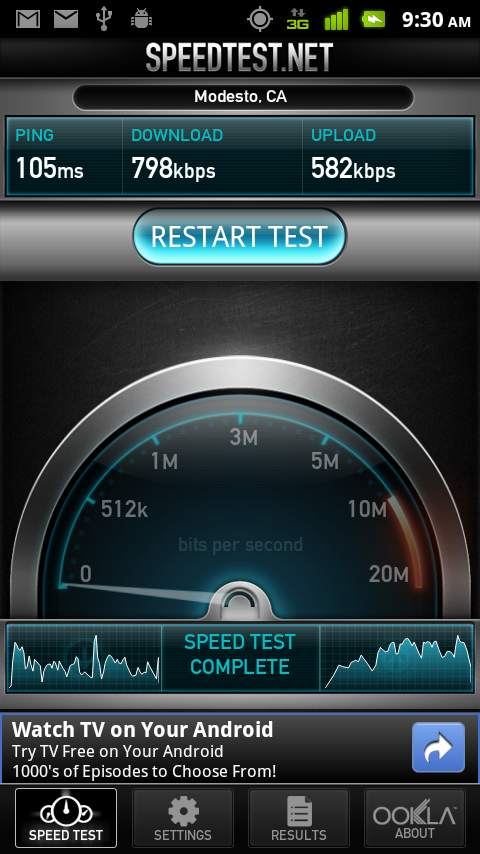
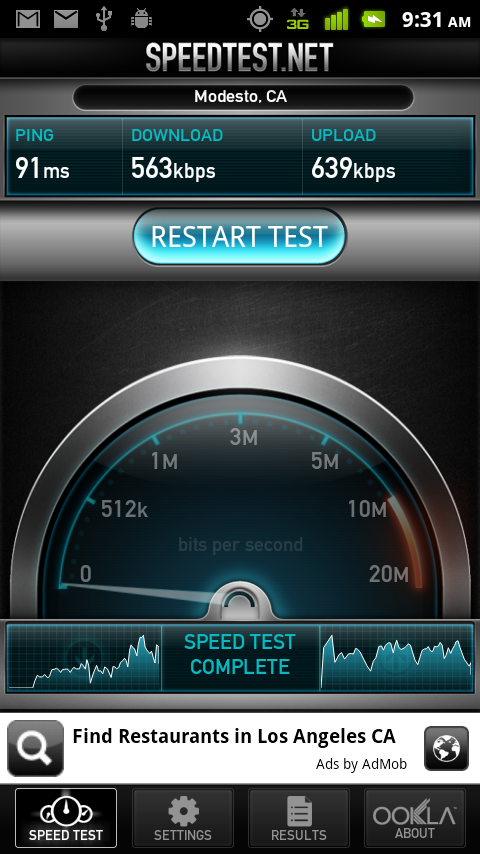
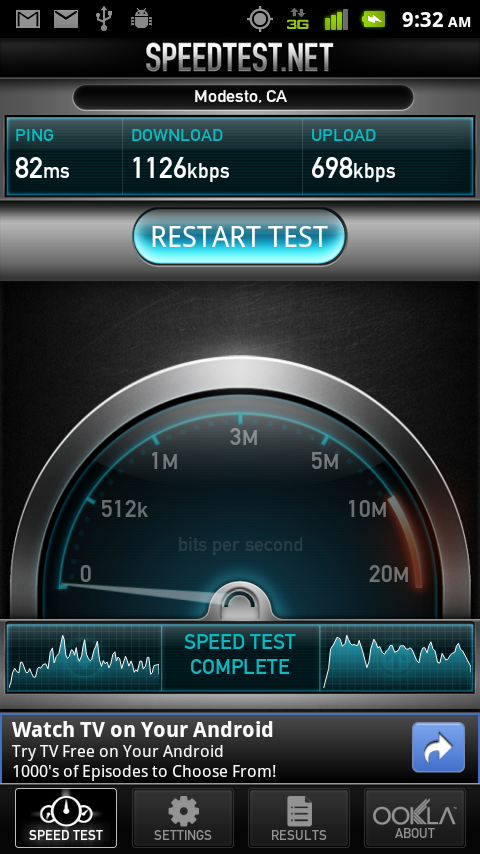
The Xperia Play advertises itself as being compatible not only with the older EV-DO Rev. 0 standard but also the newer, faster Rev. A approach. Based on the data above coupled with my prior experiences with CDMA cellular data-cognizant devices, I'm inclined to believe Sony Ericsson. The randomness of the results is somewhat intriguing; I presume it reflects a time-varying network load on whatever cell tower I happened to be connected to at the time. But considering that I saw peak download speeds of over 1.5 Mbps, for example, I'm confident in the Xperia Play's EV-DO Rev. A capabilities. For comparison's sake, here are some sequential screenshots of Speedtest.net running on my Verizon iPhone 4:


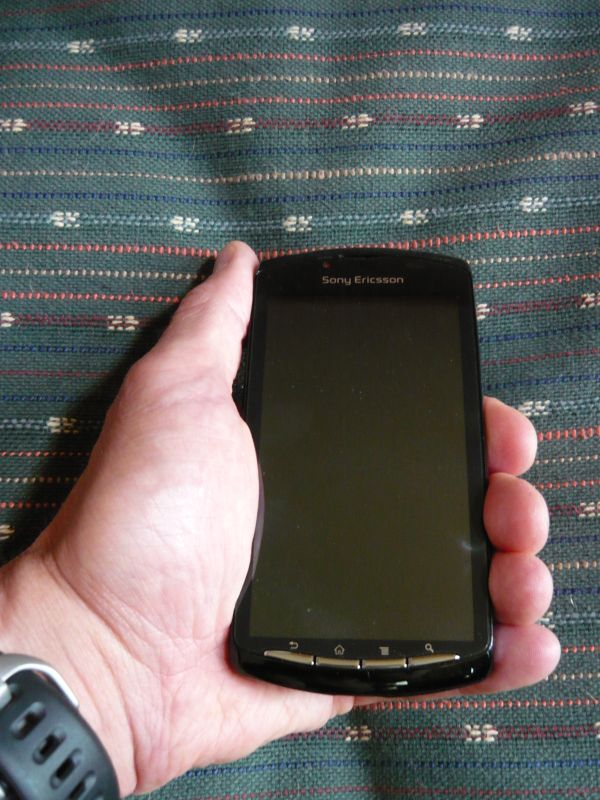
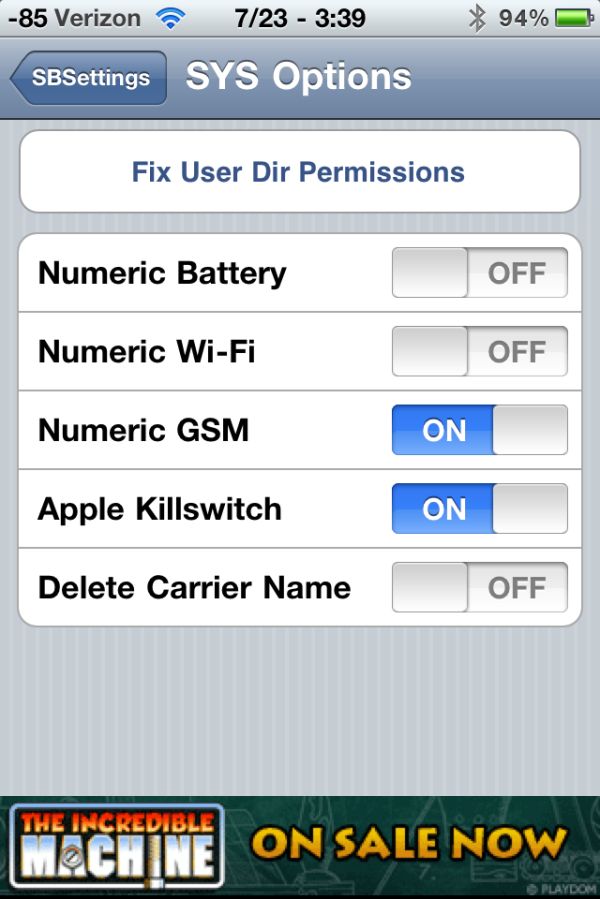
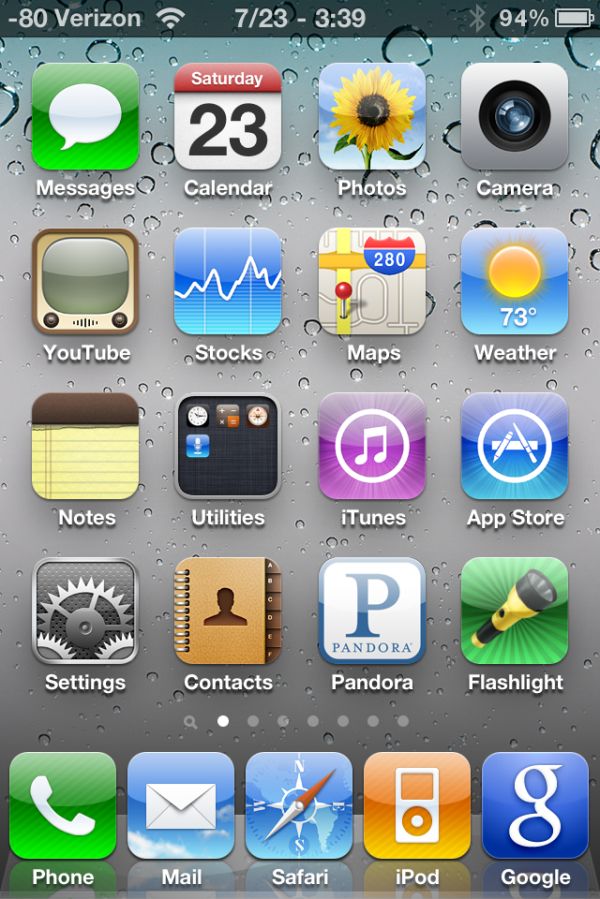
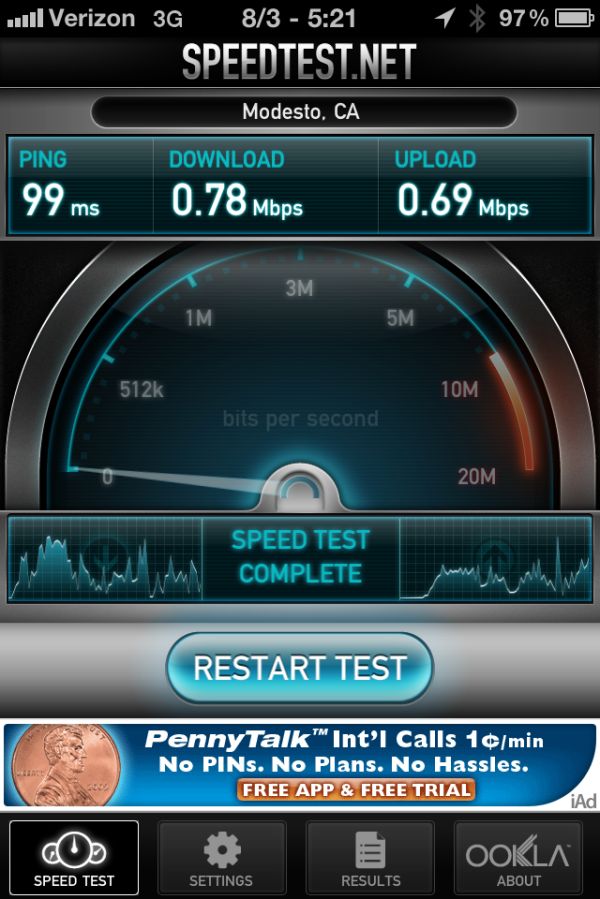
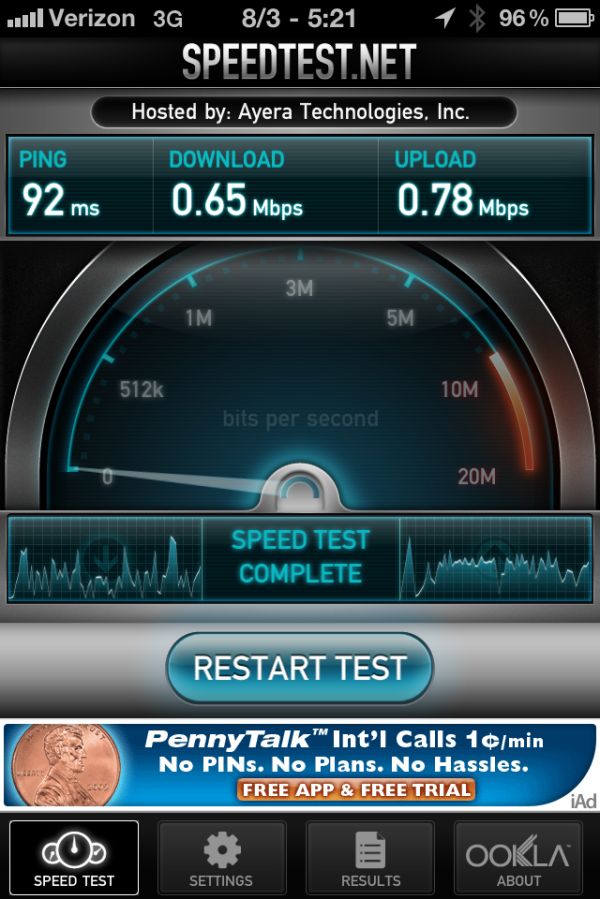
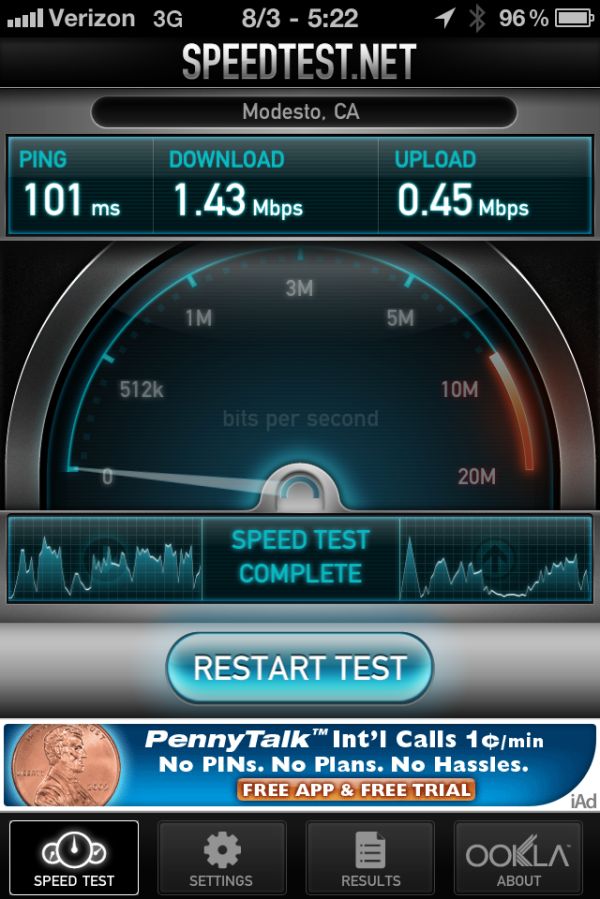








34 Comments
View All Comments
name99 - Tuesday, August 9, 2011 - link
"Yes, the silver trim is plastic, not metal, ... and minimized the potential for interference-induced antenna sensitivity degradation"Do we know that this is ACTUALLY true? Or is this high school EM applied completely inappropriately?
Obviously it is true that have metal parts in a phone affects the antenna. It's just as true that
- most phones (from a whole range of manufacturers) ship with large chunks of metal in them
- Apple's portables (those with which I am most familiar) went through a phase some years ago where the plastic MacBooks had better reception than the metal MacBook pros, but that hasn't been the case for a while. And the limited knowledge I have of Win portables (or various tablets) doesn't have people all stating unanimously "buy xxx [with a plastic cover] because its radio reception is so much better than yyy [covered with magnesium or titanium or aluminum or whatever]".
I don't have a strong opinion about this either way, but it seems to me, based on behavior across a range of manufacturers that the true state of affairs is
- if you're an amateur then using plastic is probably best because you can just ignore it BUT
- if you're a professional (and pretty much every company of interest IS now professional] you just model the entire environment (metals plus dielectrics) as finite elements. optimize the antenna for that environment, and things works out as well as they realistically can.
[And, OMG, please, if you're a commenter who feels the need to pipe up about "antenna-gate" and "grips of death", ask yourself before you comment:
- does my comment add anything useful to the question that has been posed? AND
- does my comment make me look like a retarded 14yr old with poor impulse control?]
medi01 - Wednesday, August 10, 2011 - link
I worked in EM field, and what you state is utter nonsense.You can repeat "I'm a professional, very professional, superprofessional" all day long, with "it's magical, it's very very magical" on top of it, but it still won't help you to get EM waves through the metal.
Surrept - Tuesday, August 9, 2011 - link
Is this the Brian Klug that was once bitten by a fox. It only makes sense he is on the staff here. Smartest person i've ever met in the field of computers.